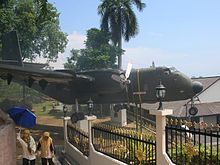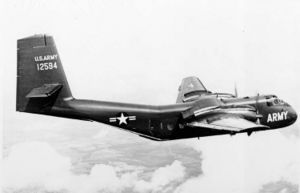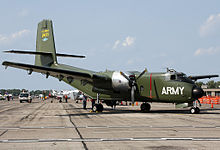- de Havilland Canada DHC-4 Caribou
-
DHC-4 Caribou A U.S. Army De Havilland Canada DHC-4 Caribou in flight. Role STOL Transport Manufacturer de Havilland Canada First flight 30 July 1958 Introduction 1961 Primary users United States Army
United States Air Force
Royal Australian Air ForceNumber built 307 Variants de Havilland Canada DHC-5 Buffalo The de Havilland Canada DHC-4 Caribou (designated by the United States military as the CV-2 and later C-7 Caribou) is a Canadian-designed and produced specialized cargo aircraft with short takeoff and landing (STOL) capability. The Caribou was first flown in 1958 and although mainly retired from military operations, is still in use in small numbers as a rugged "bush" aircraft.
Contents
Design and development
A C-7 Caribou in the U.S. Army Transportation Museum, Fort Eustis, Virginia
The de Havilland Canada company's third STOL design was a big step up in size compared to its earlier DHC Beaver and DHC Otter, and was the first DHC design powered by two engines. The Caribou, however, was similar in concept in that it was designed as a rugged STOL utility. The Caribou was primarily a military tactical transport that in commercial service found itself a small niche in cargo hauling. The United States Army ordered 173 in 1959 and took delivery in 1961 under the designation AC-1, which was changed to CV-2 Caribou in 1962.
The majority of Caribou production was destined for military operators, but the type's ruggedness and excellent STOL capabilities requiring runway lengths of only 1200 feet (365 metres)[1] also appealed to some commercial users. US certification was awarded on 23 December 1960. Ansett-MAL, which operated a single example in the New Guinea highlands, and AMOCO Ecuador were early customers, as was Air America, (a CIA front in South East Asia during the Vietnam War era for covert operations). Other civil Caribou aircraft entered commercial service after being retired from their military users.
Today only a handful are in civil use.
Operational history
 A C-7 Caribou painted in a USAF SEA camouflage scheme and marked as a 457th TAS transport, at Dover AFB Air Mobility Command Museum in July 2007.
A C-7 Caribou painted in a USAF SEA camouflage scheme and marked as a 457th TAS transport, at Dover AFB Air Mobility Command Museum in July 2007.
In response to a US Army requirement for a tactical airlifter to supply the battlefront with troops and supplies and evacuate casualties on the return journey, de Havilland Canada designed the DHC-4. With assistance from Canada's Department of Defence Production, DHC built a prototype demonstrator that flew for the first time on 30 July 1958.
Impressed with the DHC4's STOL capabilities and potential, the US Army ordered five for evaluation as YAC-1s and went on to become the largest Caribou operator. The AC-1 designation was changed in 1962 to CV-2, and then C-7 when the US Army's CV-2s were transferred to the US Air Force in 1967. US and Australian Caribous saw extensive service during the Vietnam War.
The U.S. Army purchased 159 of the aircraft and they served their purpose well as a tactical transport during the Vietnam War, where larger cargo aircraft such as the C-123 Provider and the C-130 Hercules could not land on the shorter landing strips. The aircraft could carry 32 troops or two Jeeps or similar light vehicles. The rear loading ramp could also be used for parachute dropping (also, see Air America).
Under the Johnson-McConnell agreement of 1966, the Army relinquished the fixed wing Caribou to the United States Air Force in exchange for an end to restrictions on Army rotary wing operations. On 1 January 1967, the 17th, 57th, 61st, 92nd, 134th, and 135th Aviation Companies of the U.S. Army were inactivated and their aircraft transferred respectively to the newly-activated 537th, 535th, 536th, 459th, 457th, and 458th Troop Carrier Squadrons of the USAF. On 1 August 1967 the "troop carrier" designations were changed to "tactical airlift".
Some US Caribou were captured by North Vietnamese forces and remained in service with that country through to the late 1970s. Following the war in Vietnam, all USAF Caribous were transferred to Air Force Reserve and Air National Guard airlift units pending their replacement by the C-130 Hercules in the 1980s.
All C-7s have since been phased out of the US military, with the last example serving again under US Army control through 1985 in support of the US Army's Golden Knights parachute demonstration team. Other notable military operators included Australia, Brazil, Canada, India, Malaysia and Spain.
The Royal Australian Air Force retired its last Caribou, A4-140, on 27 November 2009.[2] The aircraft, which was manufactured in 1964, was donated to the Australian War Memorial, Canberra.[3]
Brazil's Caribous are slowly being replaced by more modern EADS CASA C-295 turboprop cargo airplanes.[citation needed]
Variants
- DHC-4 Caribou
- STOL tactical transport, utility transport aircraft.
-
- CC-108
- Royal Canadian Air Force designation for the DHC-4 Caribou.
- YAC-1
- This designation was given to five DHC-4 Caribous, sold to the United States Army for evaluation.
- AC-1
- United States Army designation for the first production run of 56 DHC-4 Caribou. Later redesignated CV-2A in 1962.
- CV-2A
- United States Army AC-1 redesignated in 1962.
- CV-2B
- This designation was given to a second production run of 103 DHC-4 Caribous, which were sold to the US Army, with reinforced internal ribbing.
- C-7A/B
- These designations were applied to all 144 Caribous transferred to the US Air Force by the US Army.
- DHC-4A Caribou
- Similar to the DHC-4, but this version had an increased takeoff weight.
- DHC-4T Turbo Caribou
- A conversion of the baseline DHC-4 Caribou powered by the PWC PT6A-67T turboprop engines designed, test flown and certified by the Pen Turbo Aviation company.
Operators
Military operators
- Royal Australian Air Force
- No. 35 Squadron RAAF
- No. 38 Squadron RAAF
- RAAF Transport Flight Vietnam
- Royal Canadian Air Force; retired with the Canadian Forces
- Air Surveillance Service; Refurbished in July 2010 for the Fuerza Publica.[4]
- Imperial Iranian Air Force
- Kenya Air Force[5] operated type 1966–1987.
- Kuwait Air Force received two aircraft in 1963.[6]
- Two refurbished aircraft were delivered to the Liberian Army's, Air Reconnaissance Unit in 1989. The aircraft were destroyed during the civil war.
 RMAF Caribou on display at the Malaysian Army Museum, Port Dickson.
RMAF Caribou on display at the Malaysian Army Museum, Port Dickson.
- Malaysian Air Force retired their Caribous from active service.[7]
- Swedish Air Force operated one DHC-4 Caribou designated Tp 55 between 1962 and 1965 for evaluation purposes at F 7 Såtenäs Air Force base.[9]
- Tanzanian Air Force[9]
- Royal Thai Police The Royal Thai Police used three DHC-4A from 1966 to 2005.[10]
- Uganda Police Force Air Wing[11]
- Vietnam People's Air Force captured several ex-VNAF airplane.
- Zambian Air Force operated four Caribou.[12]
Civil operators
- Ansett-MAL operated one aircraft in the New Guinea highlands.
- La Sarre Air Services
- AMOCO Ecuador
- Anglo-Ecuador Oilfields
- Aerolíneas Cóndor of SA
- Air Inter Gabon
- Trigana Air
- New Cal Aviation
- Garamut Exploration Services
- Vanimo Trading
- Air America
- Bannock Aerospace
- Chieftain Air
- Deutsche Aviation
- Environmental Research Institute of Michigan
- Fowler Aeronautical Service
- H A T Aviation Inc.
- John Woods Inc.
- New Cal Aviation
- Pen Turbo Aviation
Incidents and accidents
On 27 August 1992 a Caribou which had modified to turboprop specification by NewCal Aviation crashed on takeoff at Gimli Industrial Park Airport in Gimli, Manitoba. 3 people aboard were killed.[14]
Aircraft on display
United States
 C-7 on display at the museum, once used by the Golden Knights parachute team
C-7 on display at the museum, once used by the Golden Knights parachute team
- de Havilland AC-1/C-7A, AF Serial No. 60-3767
- Exhibited at Jimmy Doolittle Air & Space Museum, Travis Air Force Base, Fairfield, California
- de Havilland AC-1A/C-7A, AF Serial No. 62-4188
- On display at New England Air Museum, Bradley International Airport, Connecticut
- de Havilland CV-2B/C-7B Caribou, AF Serial No. 63-9756
- Exhibited at Museum of Aviation, Robins AFB, Georgia
- de Havilland C-7A Caribou, AF Serial No. 63-9760
- Exhibited at the Air Mobility Command Museum, Dover AFB, Delaware.
- de Havilland C-7A Caribou, AF Serial No. 62-4193
- Exhibited at the 82nd Airborne Division War Memorial Museum, Fort Bragg, North Carolina.
- de Havilland C-7A Caribou, AF Serial No. 57-3083
- Exhibited at the National Museum of the United States Air Force, Wright-Patterson AFB, Ohio
- de Havilland CV-2B, AF Serial No. 62-4149
- Exhibited at Cavanaugh Flight Museum in Dallas, Texas. (fully restored to flying condition, only one in North America)[15]
Australia
- DHC-4 Caribou A4-140
- Gifted to the Australian War Memorial in November 2009.[3]
- DHC-4 Caribou A4-152
- Gifted to the Royal Australian Air Force Museum in November 2009.[3]
- DHC-4 Caribou A4-159, Nose section only.
- Queensland Air Museum, Caloundra.
- DHC-4 Caribou A4-173
- Queensland Air Museum, Caloundra.
India
- DHC-4 Caribou A4-146
- Exhibited at the Indian Air Force Museum, Palam.
Malaysia
- DHC-4 Caribou A4-248
- Exhibited at the Royal Malaysian Air Force Museum, Sungai Besi, Kuala Lumpur.
Specifications (DHC-4A)
Data from MacDonald Aircraft Handbook.[16]
General characteristics
- Crew: Three
- Capacity:
- 32 troops or
- 24 fully equipped paratroops or
- 14 casualty stretchers
- Payload: 8,000 lb (3,628 kg)
- Length: 72.58 ft (22.12 m)
- Wingspan: 95.58 ft (29.13 m)
- Height: 31.66 ft (9.65 m)
- Wing area: 912 ft² (84.7 m²)
- Empty weight: 16,920 lb (7,675 kg)
- Loaded weight: 28,500 lb (12,927 kg)
- Powerplant: 2 × Pratt and Whitney R-2000-7M2 Twin Wasp 14-cylinder, 1,450 hp (1,081 kW) each
Performance
- Maximum speed: 216 mph (348 km/h)
- Cruise speed: 181 mph (291 km/h)
- Range: 1,280 mi (2,060 km)
- Service ceiling: 24,800 ft (7,559 m)
- Rate of climb: 1,355 ft/min (413 m/min)
See also
- Related development
- DHC-5 Buffalo
- Dash 7
- Dash 8
- Aircraft of comparable role, configuration and era
References
- Notes
- ^ "Caribou Sales Brochure – 1962" (PDF). http://www.c-7acaribou.com/history/images/Caribou_Brochure_Web.pdf. Retrieved 26 May 2011.
- ^ "Defence 'workhorse' makes final flight." ABC News, 27 November 2009. Retrieved: 27 November 2009.
- ^ a b c Fitzgibbon, The Hon. Joel, (MP), Minister for Defence. "Honouring the Caribou's Service to Australia." Department of Defence, 9 March 2009. Retrieved: 9 March 2009.
- ^ "Fuerza Pública revive avión militar Caribú – SUCESOS – La Nación". Nacion.com. http://www.nacion.com/2010-07-30/Sucesos/UltimaHora/Sucesos2467068.aspx. Retrieved 26 May 2011.
- ^ Andrade 1982, p. 141.
- ^ "',Kuwait Air Force (KAF)', entry at the ',Scramble', magazine website". Scramble.nl. http://www.scramble.nl/kw.htm. Retrieved 26 May 2011.
- ^ "',Malaysian Forces Overview', entry at the ',Scramble', magazine website". Scramble.nl. http://www.scramble.nl/my.htm. Retrieved 26 May 2011.
- ^ "',Royal Air Force of Oman', entry at the ',Scramble', magazine website". Scramble.nl. http://www.scramble.nl/om.htm. Retrieved 26 May 2011.
- ^ a b Wayne Buser (4 September 2010). "',Caribou Roster',". Dhc4and5.org. http://www.dhc4and5.org/Roster.html. Retrieved 26 May 2011.
- ^ Royal Thai Police
- ^ Andrade 1982, p. 231.
- ^ Taylor 1971, p. 19.
- ^ "Serial MSP002 C-7A MSN 149". Scramble.nl. http://www.scramble.nl/crbase.htm. Retrieved 26 May 2011.
- ^ "ASN Aircraft accident de Havilland Canada DHC-4T Caribou N400NC Gimli, MB:". Aviation Safety Network. http://aviation-safety.net/database/record.php?id=19920827-1. Retrieved 28 March 2011.
- ^ "De Havilland CV-2B Caribou". Cavanaugh Flight Museum. 20 June 1963. http://www.cavanaughflightmuseum.com/CV-2B.html. Retrieved 26 May 2011.
- ^ Green 1964, p. 249.
- Bibliography
- Andrade, John. Militair 1982. London: Aviation Press, 1982. ISBN 0-907898-01-7.
- The C-7A Caribou Association
- Caribou Roster deHavilland Caribou (DHC-4) and Buffalo (DHC-5) web site.
- "Caribou to Bow Out Early". Air International, Vol. 76. No. 4, April 2009, p. 5.
- Green, William. Macdonald Aircraft Handbook. London. Macdonald & Co. (Publishers) Ltd., 1964.
- Hotson, Fred W. The de Havilland Canada Story. Toronto: CANAV Books, 1983. ISBN 0-07-549483-3.
- Kuwait Air Force (KAF) entry at the ISBN 978-0710612625.
External links
- GlobalSecurity.org: C-7 / CV-2 Caribou
- DHC-4T Turbo Caribou Imagery
- Replacing the Caribou: the Tango Charlie Option (DHC-4T) – Defence Today
- Bush planes
- The C-7A Caribou Association
de Havilland Canada aircraft DHC-1 · DHC-2 · DHC-3 · DHC-4 · DHC-5 · DHC-6 · DHC-7 · DHC-8
CS2F Tracker · Gipsy Moth · Tiger Moth · Fox Moth · Mosquito
Canadian Forces unified aircraft designations post-1968 100-125 126–150 151- US Army airplane designations 1955-1962 Airplane, Cargo AC-1 • AC-2
Airplane, Observation Airplane, Experimental United States tri-service transport designations post-1962 C-1 · C-2 · C-3 · C-4 · C-5 · C-6 · C-7 · C-8 · C-9 · KC-10 · C-11 · C-12 · (C-13 not assigned) • C-14 · C-15 · (C-16 not assigned) • C-17 · C-18 · C-19 · C-20A/B/C/D · C-20F/G/H · C-21 · C-22 · C-23 · C-24 · C-25 · C-26 · C-27 / C-27J · C-28 · C-29 · (C-30 not assigned) • C-31 · C-32 · C-33 · C-35 · (C-36 not assigned) • C-37 · C-38 · C-40 · C-41 · (C-42 to C-44 not assigned) • KC-45 • KC-46
See also: C-143 · C-144 · KC-767 · Pre-1962 list United States tri-service STOL and VTOL aircraft designations post-1962 Swedish Air Force military aircraft designations 1940–present B/S/T/Tp 16 - Sk 16 • B/S 17 • B/S/T 18 • J 19 • J 20 • A/J 21 • J/S 22 • J 23 • B/J 24 - Tp 24 • Sk 25 • Sk 26 - B/S 26 - J/S 26 • J 27 • A/J/Sk 28 • A/J/S 29 • J 30 • S 31 • A/J/S 32 • J 33 • J 34 • J/S/Sk 35 • A 36 • AJ/JA 37 • A/Sk 38 • JAS 39 • Tp 45 • Tp 46 • Tp 47 • Sk 50 • Fpl 51 • Tp 52 • Tp 53 • Fpl 54 - Tp 54 • Tp 55 • Sk 60 • Sk/Fpl 61 • Tp 78 • Tp 79 • Tp 80 • Tp 81 • Tp 82 • Tp 83 • Tp 84 • Tp 85 • Tp 86 • Tp 87 • Tp 88 • Tp 89 • Tp 91 • Tp 100 • Tp 101 • Tp 102 • Tp 103
Lists relating to aviation General Aircraft (manufacturers) · Aircraft engines (manufacturers) · Airlines (defunct) · Airports · Civil authorities · Museums · Registration prefixes · Rotorcraft (manufacturers) · TimelineMilitary Accidents/incidents Records Categories:- Canadian civil utility aircraft 1950–1959
- Canadian military transport aircraft 1950–1959
- Military aircraft of the Vietnam War
- De Havilland Canada aircraft
- Twin-engined aircraft
Wikimedia Foundation. 2010.




